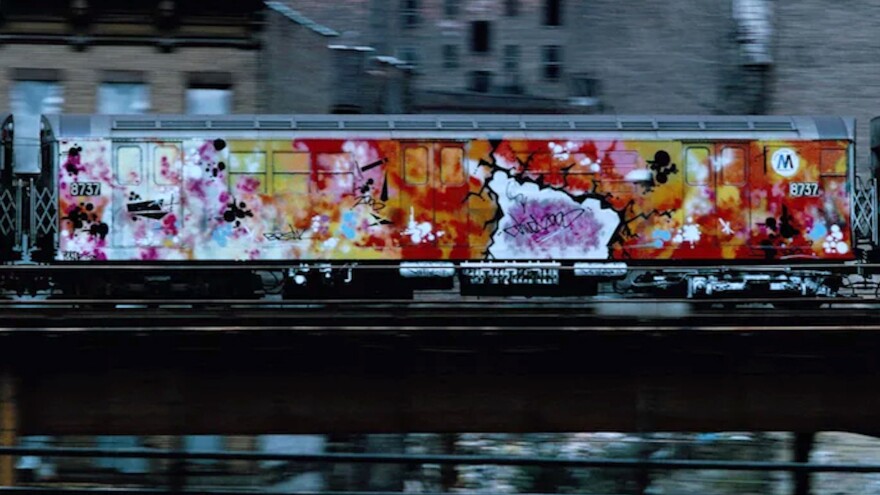After graduating from college in 1978, moved to New York City for a job on Wall Street, but he says his interests soon led him elsewhere. "I'd take myself to the 1 train stop on Hudson and Chambers and these trains would roll in with these graffiti burners, covering the train from top to bottom. And I just couldn't believe what I was seeing- it was this sort of beautiful vandalism."
Then Holman read a short blurb in The Village Voice. Fred Brathwaite, who served as an informal spokesperson for the Fabulous 5 graffiti crew, put out a call for readers to hire them to create custom burners at their businesses or homes, priced by the square foot. Intrigued, Holman called and invited him to hang out.
Later that year . Then in 1980, Freddy painted on a New York City subway car- a string of soup cans that doubled as an announcement of his arrival as a significant creative catalyst.
As grew, it expanded beyond visual art. He brought DJs Afrika Bambaataa and Jazzy Jay downtown to perform at the Mudd Club, and took Chris Stein and Debbie Harry up to the Bronx to see - an exchange commemorated in Blondie's No. 1 hit song Harry then introduced the rappers Funky 4 + 1 when , and brought them along as , where rap had its national television debut.
When English punk rockers . The band's single "Magnificent Seven/Magnificent Dance" became a hit on pirate and college radio, as well as on New York's legendary Black station WBLS. Returning to the city for a 17-date string of shows at Bonds International Casino in the summer of '81, The Clash brought on rappers such as Grandmaster Flash & the Furious Five as openers and invited the artist (then Futura 2000) to paint live
Although some of expressed resistance to these creative alliances, the band to championing them. When the tour continued to Europe, The Clash took Futura along and collaborated with him on , which he performed live in Paris.
At the same time, back in New York, . "He was dressed like a Pirate from the Penzance on acid," Holman recalls. "Pantaloon pants and bright orange this and that, crazy- you know, like Culture Club."
Perhaps more like a culture clash, but Holman says something magical happened. "Jazzy [Jay] gets on the turntable and starts to scratch records, and quick cut, and do all of these isolated, you know, B-beats, and I'm saying to Malcolm, 'See what he's doing? That's like special mix DJing. And see that kid over there- he's like breakdancing, and see that over there? That's graffiti. And Ikey-C on the mic- that's rapping.' And Malcolm, like a lightbulb goes on, and he's like 'I get it.'"
In September of '81 McLaren asked Holman to put together a show featuring DJing, MCing, breaking, and visual art as an opener for the band Bow Wow Wow in New York. That led to a weekly revue at a club called Negril, where B-boys the Rock Steady Crew and Floor Masters (later the New York City Breakers) battled on the dance floor.

Another McLaren associate, Ruza "Kool Lady" Blue got things going at the Roxy, a massive roller rink where she added one more element to the mix by bringing in the team, winners of the 1980 worldwide championship.
In the summer of 1982, the Roxy became the epicenter of New York's nascent multiracial youth culture. Building on that momentum, Fab 5 Freddy, "Kool Lady" Blue, and French journalist brought hip-hop to Europe. Dubbed the "New York City Rap Tour," the sojourn kicked off on , then moved on to Lyon, Belfort, Mulhouse, Strasbourg, London, and Los Angeles. Bringing all of the elements of hip-hop together, it showcased dozens of artists- including the Fantastic Four, Futura, the Rock Steady Crew, as well as Afrika Bambaataa, Phase 2, Dondi, GrandMixer D.ST (now DXT) and Rammellzee.
Photographer was on assignment from Melody Maker to cover the London show. At the time she had been shooting two or three bands a week, mostly punk acts in small clubs. "It would be dark and, you know, people would be pogoing, spitting and shouting," she recalls. Beckman had never encountered artists scratching, rapping, breaking, making graffiti art, or doing double dutch- let alone at the same time. Nor had she seen the audience responding with such rapt attention.

"It was so different from anything we knew," she says. "It seemed full of joy I have to say." Although the journalist who accompanied her dismissed hip-hop as a passing fad, shortly after the tour Beckman moved to New York in 1983, and went on to photograph emerging artists such as , , and who would soon become iconic. By then hip-hop was already showing up in films such as , , and Flashdance, setting the stage for its global ascendance. Four decades later, it's still central to music, art, and fashion, and is even gaining recognition in the world of Olympic sports, where .
Copyright 2022 NPR. To see more, visit https://www.npr.org.



